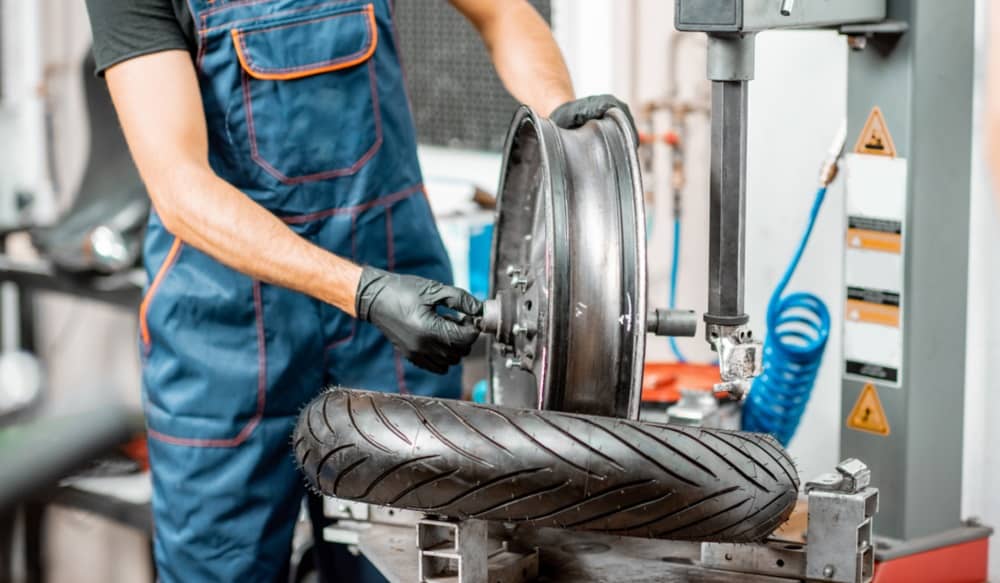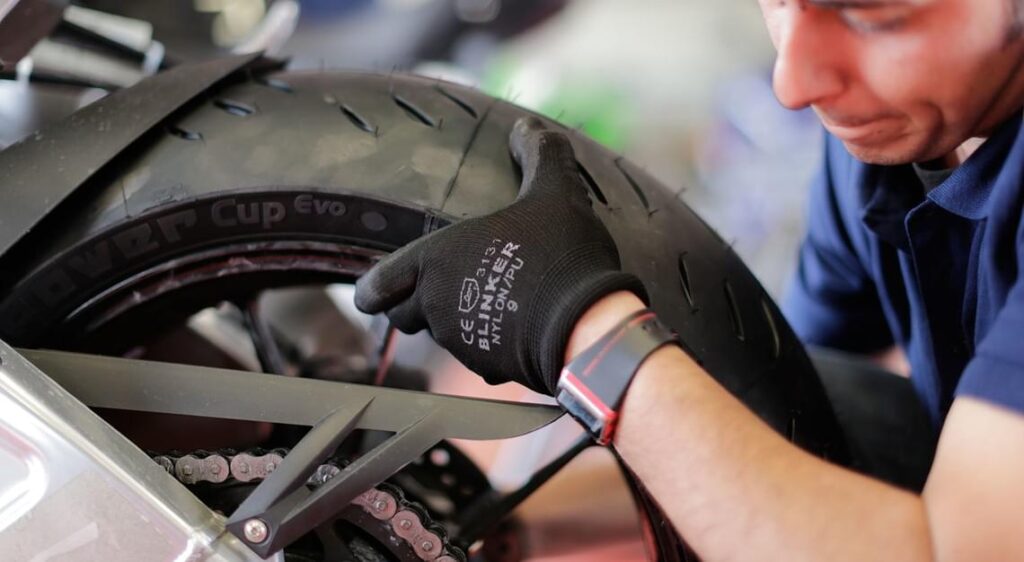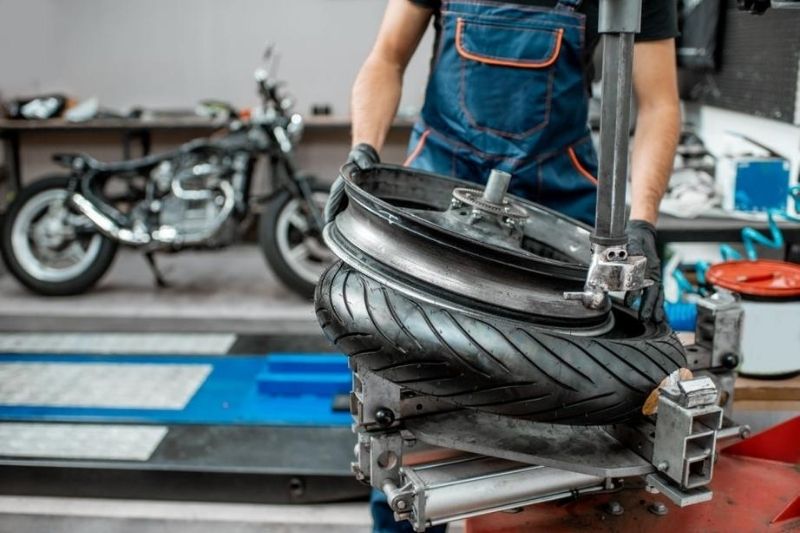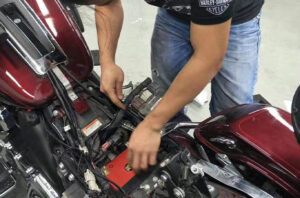Whether your motorcycle tires are flat or it’s time for a replacement, you can easily remove the old tire and put on the new one, and it’s 100% doable once you have the right tools. So sit back and relax as we walk you through the process step by step.
When Need To Change Motorcycle Tires

- 1. Tire puncture
The tires are durable enough to withstand shocks but sometimes puncture. If your tires are flat, they should be replaced by a professional mechanic.
- 2. The legal tread wear limit has been reached
The Michelin Man symbol on the upper side of the tire means it has a tread wear indicator. Similar to the small protrusions, these protrusions are located at the bottom of the main groove.
When the rubber wears to this level, the tire has reached 2/32 of its legal wear limit. Michelin strongly recommends changing your tires before you get to this point. Beyond this point, there is no guarantee that your tires will remain safe or provide grip and performance, especially on wet surfaces.
- 3. The tires have signs of aging
It is difficult to predict the life of a tire because it has nothing to do with the date of manufacture. Tires that have never been used or are only rarely used may still show signs of aging. There are many factors that affect its longevity: weather conditions, storage and usage conditions, load, speed, tire pressure, maintenance, riding style, etc.
Michelin recommends that all drivers take some time to inspect their tires regularly for any external signs of age or wear, such as deformations or cracks in the tread, shoulders, or sides.
You should also have your tires inspected by a professional, who can assess whether they should be replaced.
After 5 years of use or more, tires should be inspected annually by a professional mechanic. If a tire needs to be replaced, follow the manufacturer’s recommendations for replacing the original parts. As a precaution, all tires that have not been replaced after ten years should be replaced, even if they are in generally good condition and have not reached the tread wear limit.
- 4. Tire damage
Road surfaces, holes or blunt objects can seriously damage tires. All tears, cuts or deformations should be carefully inspected by a professional mechanic.
In general, do not ride on damaged or flat tires. If a tire blows out, it should be replaced.
- 5. Abnormal wear of tires
Abnormal wear of the tire tread (localized in places, center or shoulders) is usually a sign of a mechanical problem (wear of shock absorbers, derailleurs, mounts, etc.) or a balance problem. Incorrect tire pressure can also cause this.
To prevent abnormal wear, check wheel balance every six months. This will extend tire life and ensure a more comfortable ride. Apart from that, your tires may wear excessively over the mileage compared to other motorcycles run in the exact same conditions.
- 6. Your vehicle tires are wrong
Tires are selected based on legal requirements and the type of equipment recommended for the vehicle. For best performance, use tires with the same tread pattern front and rear. Tires with different designs tread and wear patterns can affect the balance and stability of the vehicle. Never install a vehicle with one radial tire and one non-radial tire unless the manufacturer specifies otherwise.
How to Change a Motorcycle Tire

Removing the Motorcycle Wheel
The first thing you have to do is put the motorcycle in the air. For this, you can use a jack or a stand. Each option works well as long as they are positioned correctly and high enough to remove the wheel. Make sure the motorcycle is stable! The last thing you want is to turn a simple tire change into fixing a dent on the gas tank.
Front Wheel: Front wheel removal is easy as the brake disc remains on the wheel. Just remove the axle and put something between the brake lever and the handlebars. This action prevents accidental activation of the brakes.
Rear Wheel: Loosen the chain or belt adjuster and remove the chain/belt. Shaft-driven motorcycles will replace this step by loosening the drive shaft. Pull out the axle and note the location of any spacers or washers.
Remove the tire
With the wheel off the bike, make sure the tube is fully deflated. Then, loosen the valve lock nut and push it back into the tire. Next, walk on and around the tire, using your heel to make sure the bead is clear of the rim.
Using the tire lever, begin to loosen the tire rim on rim. You’ll need several tire levers because the first lever should stay in place while working around the tire.
This removal stage is physical, but tire lubricant or a diluted soap solution will aid the process.
With no rim on one side, remove the inner tube and place the wheel upright. Then, use the same method to fully release the tire.
Install new tires
First, check the travel direction arrow for the new tire and align it with the wheel accordingly. Then, reverse the removal process to fit one side of the tire onto the rim. Next, push the inner tube in, locating the tire valve through the hole in the rim. Partially inflate the inner tube to help prevent accidental pinching. Then, use the tire lever to install the other side of the tire. Tighten the valve lock nut and inflate.
Change wheels
Reinstalling the wheel after changing the motorcycle tire
Before putting the wheel back on the motorcycle, remove any tire oil or soap and inspect the tire for leaks.
Double check the orientation of the tires and whether they are properly inflated.
Finally, reinstall the wheel to the bike, making sure all spacers or washers are back in the correct order. Then, tighten the nuts and bolts to the correct torque setting. If your motorcycle is equipped with a chain or belt tension, don’t forget to adjust the chain or belt tension.
Summary
If this is your first time changing your own motorcycle tires, this may seem like a daunting task. It requires more muscle and skill than brain power. If you’re concerned about scratching the rim, be sure to put cardboard or a towel on your work surface. If you do scratch the rim, you’re not damaging your bike, you’re just adding character to it.
Changing your own motorcycle tires is a skill that any home garage mechanic can easily master and do. The next step is to balance the motorcycle tires.



